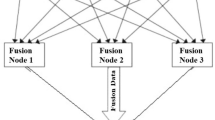Abstract
Large amounts of data in the ultra-low temperature online monitoring system is needed to monitor and transmit in real time, at the same time. The data collected is usually erroneous because of the characteristics of sensors itself. In order to solve this problem, the data fusion technology is applied to the ultra-low temperature online monitoring system, and erroneous data will be removed through correlation function careless error elimination method based on the fuzzy theory. The reliability and effectiveness of the whole monitoring system is improved. According to the theory above, an ultra-low temperature online monitoring system is designed in this paper. In this paper, the overall structure of the ultra low temperature on-line monitoring system is introduced in detail, the hardware and software design of the system was analyzed, and the whole system was tested. The test results show that the system is stable and reliable with very important market application value.





Similar content being viewed by others
References
Wang, J., Lin, J., & Xie, S. (2015). The environment monitoring system based on wireless sensor network. Chinese Journal of Sensors and Actuators, 28(11), 1732–1740.
Yang, G., Li, S., Chen, Z., et al. (2013). High-accuracy and privacy -preserving oriented data aggregation algorithm in sensor networks. Chinese Journal of Computers, 36(1), 189–195.
Li, Z., & Pei, J. (2015). Distribute manhole cover monitoring and controlling system based on zigbee. Science and Technology Information, 31(3), 170–173.
Qian, Z., & Wang, Y. (2013). Internet of things-oriented wireless sensor networks review. Electronics and Information Journal, 1, 215–227.
Chen, K., Zhang, H., Zhang, Y., et al. (2014). Design of CC2530 based gateway node for wireless sensor network. Journal of Northwest A & F University (Natural Science Edition), 05, 183–188.
Qiang, S., Hu, S., Zang, X., et al. (2015). Design of monitoring and control system on greenhouse environment factor based on zigbee technology. Journal of Guangxi Normal University: Natural Science, 33(3), 28–32.
Li, P., Zheng, Z., & Chen, P. (2014). Application of multi-sensor data fusion in agricultural greenhouses monitoring system. Wireless Communications Technology, 4, 27–31.
Li, S. (2015). The approach of dynamic data fusion based on multi-sensor temperature data. Chinese Science and Technology, 31(1), 146–149.
Chen, C., Cui, L., Xu, T., et al. (2016). Wireless-sensor and multi-data fusion technological research of sunlight greenhouse. Journal of Shenyang Agricultural University, 47(1), 86–91.
Acknowledgements
The authors acknowledge the financial support provided by a Project of Shandong Province Higher Educational Science and Technology Program (Grant No. J16LN75).
Author information
Authors and Affiliations
Corresponding author
Rights and permissions
About this article
Cite this article
Zhao, M., Liu, P., Cao, A. et al. Design of Ultra-Low Temperature Online Monitoring System Based on Data Fusion Technology. Wireless Pers Commun 103, 481–489 (2018). https://doi.org/10.1007/s11277-018-5455-5
Published:
Issue Date:
DOI: https://doi.org/10.1007/s11277-018-5455-5




